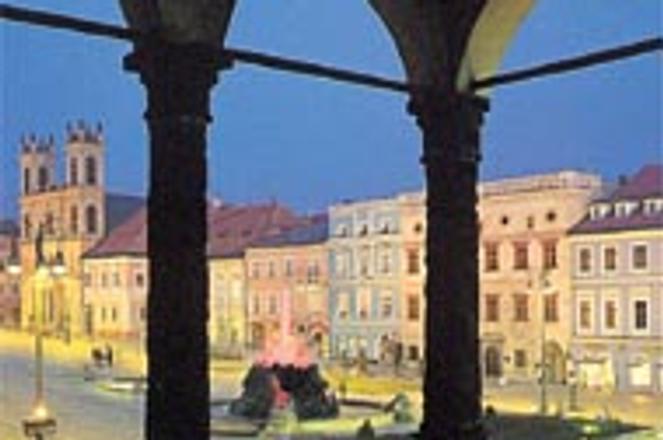Beautiful Námestie SNP. The square, which served as a bus depot under Communism, was renovated just before Slovakia celebrated the 50th anniversary of the anti-fascist Slovak National Uprising on August 29, 1994.
The people of Banská Bystrica know their town is beautiful, and they are proud of it. It is in their eyes as they think about their new square, about the National Bank and Ministry of Transportation, Post, and Telecommunications moving their centers to their city. It has elevated their sense of importance and added a bounce to their step, which is evident any time of year.
November is likely to be wet in Banská Bystrica. Gray clouds hide the Low Tatra mountains that begin their ascent north of the town. All around, the gentle foothills soak in the rain. The Hron river can be heard hurrying along. Every side street that connects with the central SNP (Slovak National Uprising) Square bustles with people ducking into shops or newly reconstructed offices.
The square itself is a majestic cobblestoned slope lined with 400-year-old buildings. A statue of the Virgin Mary is perched at the top of the square underneath an old clock tower that leans 40 cm to the left. A colorful fountain and memorial to the Russians that liberated the town in 1945 complete the center, as beacons atop old-style lamp posts illuminate the square in the early evening.
The bottom of the square narrows into Dolná Street, an emerald-colored road that leads past cafés, hip shops, art galleries and pubs to the river. Standing at the top of the square, one clearly sees the city of Banská Bystrica unfolding proudly.
Home to an uprising
It wasn't always this way. It is now hard to imagine the square as a giant bus stop, stripped of its present charm. But that is how it was before renovations were completed for 1994's 50th anniversary of the Slovak National Uprising.
Much of the citizens' high self esteem has its roots in the fact that Banská Bystrica was the center of Slovakia's anti-fascist uprising during WW II. Along the city's old castle wall, a white oval structure split in half with two steel columns protecting a flame in the middle houses the vast historical artifacts of that struggle against fascism.
The SNP Museum is a good war museum. The first half of the museum's exhibit documents the creation of an autonomous Slovak Republic and short-lived first Slovak state.The second half of the exhibit is dedicated to the uprising, which was the second-largest in Europe against the fascists, behind that of Warsaw.
The museum has helpful guides, who speak both English and German, and interesting film footage from that time.
From the museum, follow the path through a park of tanks and anti-aircraft guns pointed to the hills back to the square. On weekends, the leaning clock tower is open from 10 a.m. until 5 p.m. to the public for an impressive view of the surroundings.
Immediately standing out from this view are three buildings on the square. The 16th century building on the left called Mittelhaus (middle house) was reconstructed in 1958 and currently serves as the Central Slovakia Museum. The next on the right is the Benického dom (Venetian House), which draws the eye with its scenes of medieval times painted underneath an arcade. The last is the large yellow building on the left owned by the Thurzo-Fugger Corporation in the 16th century. Here the vast wealth of mining in the hills surrounding the town was administered.
All three buildings were once owned by the Hungarian Thurzo family, but today they are part of one of the most pcturesque squares in Slovakia - a square to be proud of.
S&S Travel tips
Kultúrne a Informačne Stredisko- Nám. SNP 18, 088/723-953
How to get there
Most train connections to Banská Bystrica require a transfer in Zvolen about 30 minutes away. (Bratislava to Zvolen takes 3 hours.) Several buses a day run from Bratislava (4 hours) and Košice (about 5 hours). Note that the last bus to Bratislava leaves by 18:00.
Important Places
Slovak National Uprising Museum- Kapitulská 23, (east of the city center near Moyzesova ul.), 088/237-16. An extensive collection of WW I and WWII artifacts. Don't miss the film presentation on the Slovak National Uprising, which they have in English. Open Tue-Sun 8-18 (May-Sept); 9 - 16 (Oct. - April).
Parish Church, St. Barbara- Located at the center of the citadel at the western end of SNP square. 13th century Romanesque structure, Notable for its side gothic altar piece of St. Barbara, the patron saint of miners, by Master Pavol of Levoča. The side panel paintings are intriguing as well; check out Saint Ursula and her collection of shipwrecked virgins.
Central Slovakia Museum, Thurzo's house- Nám. SNP 4, (088) 542 92. The house is more interesting than the museum. Lots of mining history. Open Mon-Fri. 8 - 12 and 13-16, Sun 9-16.
The State Gallery- Dolná ul. 8, 088/241-67, 248-64. Showing art from Slovakia, especially the surrounding region, and from abroad, the gallery is perhaps more interesting for its facility, which makes up part of Banská Bystrica's castle complex. Open Tue-Fri 10-18, Sat 10-15.
Hotels
Hotel Madona- Zvolenská cesta 27, 088/760-330. Can sleep 28. Small cozy hotel with breakfast. Double room, 300 Sk.
Hotel Urpín- J. Cikkera 5, 088/724-007. 460 - 680 Sk for foreigners per person. Classic (communist) style hotel with standard fare.
Hotel Turist, ATC- Tajovského cesta 9, 088/735-590. Nothing special. 200 Sk per room.
Chata Irisa- Suchý vrch, 088/347 443. Small place with friendly enough service. 180 Sk per room for foreigners . Breakfast 30 Sk.
Hotel ZVT- Podháj 57, 088/761-256. A little outside the city in peaceful surroundings. 160 Sk per person for foreigners.
Hotel Arcade- Nám. SNP 5. 088/702-111. Luxury hotel with all the amenities in a restored building on the main square. Good service, plus there is a great vináreň in the basement. Double 1,890 Sk for Slovaks, 2,170 Sk for foreigners with breakfast.


